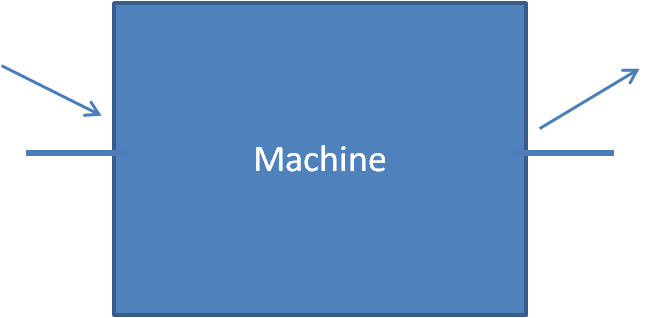Entrepreneurs You Are Machine Builders
Previously I wrote about the most common misconceptions and lies of entrepreneurs. Here we will talk about the correct vision of the modern entrepreneur. The way I have learned and understand it best is using the metaphor of building machines.
I view a business as a machine, simple or complex, that generates a profit. It may sound overly simple at first but at the core that is the idea. In my head I see the machine as a box that has an input on one side and an output on the other side. Into the input the entrepreneur inserts resources which may include some or all of the following: time, money, energy, capital, etc. On the other side of the machine money comes out. The work of the entrepreneur is to make sure that more money comes out of the output than went into the input. This often requires taking the machine apart and changing the mechanics to make the machine more efficient. See image below.
The good thing about building a business is that you can start just by building the simplest form of your machine (often called the minimal viable product or MVP). Put differently you want to start by inserting one dollar of resources into the machine and tweak the machine until two dollars come out the other side. Once you have these core “nuts and bolts” configured you can start to input one hundred dollars into one side and expect two hundred dollars to come out the other side.
An example of a simple machine
An entrepreneur may write an extensive guide on how to do something… say, “How to install surround sound speakers into your walls and ceiling without hiring a contractor.” The entrepreneur spends $50 on some advertisements on Google to appear when people search for “How to install speakers in walls.” The entrepreneur charges $25 for the downloadable book on their website and makes four sales from the $50 in advertising. $50 went into the machine and $100 came out the other side. There was some other initial capital that went into the guide and the website but those costs will be minimal inputs over time as the machine outputs revenue.
An example of a complex machine
Proctor and Gamble employ a R&D team to experiment with various chemicals to come up with new product ideas. One of the engineers figures out how to engineer a chemical to effectively get rid of odors. The company spends a few hundred thousand dollars working on the formula and product branding. Then another few hundred thousand to do focus groups and product testing. Eventually P&G does a test launch of the product in select Walmart stores. After a few months of figuring out what packaging makes it move off the shelves P&G invests a few million dollars in that local market for TV advertising about the product. They spend a few hundred thousand to create a few different versions of the ad to find out which version works best to educate consumers. Eventually the right formula of packaging and marketing is discovered and the product is launched nationally. We haven't even talked about the complexity of manufacturing and distribution. At this point several million dollars are put into the machine and it begins to turn out millions.
Complex machines tend to carry much greater risk and liability because so much more money may have to go into the machine to test if it works. This is why today's entrepreneurs are more focused than ever on developing a minimal viable product in order to test the machine at a low scale. Once the machine functions the entrepreneur can scale it into a big business by inputting more resources.
Once the entrepreneur discovers the tricks of machine building its much easier to replicate the process with new product ideas.
So the question is, what machine are you building?

